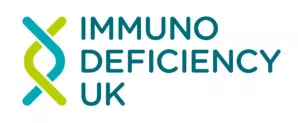Summary
This information explains the rare immune condition called NEMO (nuclear factor-kappa B essential modulator) deficiency syndrome. The content has been produced jointly between Immunodeficiency UK, Great Ormond Street Hospital (GOSH) and the Great North Children’s Hospital.
NEMO (nuclear factor-kappa B essential modulator) deficiency syndrome is a rare disorder and is often referred to simply as NEMO deficiency. It causes major abnormalities of the immune system but can affect many parts of the body, particularly the skin, hair, teeth and brain. NEMO is a protein in white blood cells that signals infection. The protein is also present in other cells, such as the skin and teeth, where it is important in making the sweat glands, hair and normal-looking teeth. NEMO deficiency is one of a larger group of conditions known as primary immunodeficiencies. It is very variable in the symptoms it causes and how it progresses over time. Another name for the condition is X-linked hypohydrotic ectodermal dysplasia and immunodeficiency (XL-EDA-ID).
Causes of NEMO
NEMO deficiency is usually an inherited condition, passed on in families in the same way that physical characteristics, such as eye colour, are passed from parent to child. It is caused by a mutation (change) in a child’s genetic make-up.
In boys with NEMO deficiency, one gene called IKBKG contains a spelling mistake (or mutation) that interferes with the normal function of the protein it makes, called NEMO. NEMO usually does an important job inside white blood cells as well as in the skin, where it is involved in developing teeth and hair.
As the IKBKG gene is located on the X chromosome, girls have a back-up copy so are very rarely affected. However, each time a female carrier has a baby boy, there is a 50 per cent chance her son will inherit the X chromosome bearing the mutated gene. This is called X-linked inheritance.
Sometimes new gene defects can occur ‘out of the blue’ in people with no history of the disorder in their family. If the genetic change occurs at the time of conception (in the eggs or sperm) it is called ‘sporadic’ and could be passed on to the next generation. If it occurs later in the development of the embryo, the gene mutation only affects blood cells and is called a ‘somatic’ variant. In this case, the genetic defect cannot be passed on to future generations.
Specialists in genetics and genetic counselling are on hand to talk through the inheritance of NEMO with you if needed. More information about genetics is also available in our separate leaflet ‘Genetics aspects of primary immunodeficiency’.
The first sign of NEMO deficiency is often a severe infection, such as meningitis or pneumonia, requiring hospital treatment and sometimes intensive care. Boys with NEMO deficiency are vulnerable to many types of germs because so many aspects of their immune system are impaired. The major culprits are bacteria called Pneumococci, relatives of tuberculosis (TB) called atypical mycobacteria and a fungus called Pneumocystis, but viral infections may also be a problem.
As well as being unable to fight infections as well as usual, the immune system may develop an ‘autoimmune response’ – that is, it starts to attack the body cells instead of foreign invaders, such as bacteria and viruses. If the autoimmune problems affects the guts it can cause diarrhoea and abdominal pain.
In NEMO deficiency, skin is usually very dry and thickened owing to of a lack of sweat glands. Hair is usually sparse. Teeth tend to have an unusual, round (conical) shape. This is called ectodermal dysplasia. Those affected may also develop multiple skin abscesses and a skin condition called molluscum contagiosum. Some boys may have swollen arms or legs owing to fluid retention (lymphoedema).
The most important step is recognising that there is a problem with the immune system and involving the right specialists to investigate further and determine treatment. The combination of skin and teeth abnormalities with severe infections can be very characteristic. Blood tests often show weak responses to vaccines and germs. They may also show signs of infection or autoimmune response. Genetic tests – also requiring a blood sample – will be needed to identify the mutation on the NEMO gene.
The immediate priority is to diagnose and treat infection. Many boys have severe problems with their immunity and require complex treatment from an immunology specialist, possibly in hospital at first. Most patients will need antibiotics as well as immunoglobulin replacement treatment in the long term to prevent infection, but this can often be given at home.
Live vaccines should not be given to children with NEMO deficiency as they may be harmful. Regular monitoring and check-ups will help to catch infections early. If an autoimmune response occurs, this can be treated with steroid and/or other medicines to damp down the immune system, so relieving the symptoms. Skin complaints, such as eczema, may need to be managed.
In some severely affected patients, NEMO deficiency may need treatment using stem cell transplantation (HSCT). This is a fairly new treatment for NEMO deficiency, so its role is still being established. It is important to remember that a bone marrow transplant will resolve the problems with the immune system, but not the skin, teeth and hair. Studies are ongoing to understand better what this means in the long term.
The outlook for children with NEMO deficiency is variable. With regular monitoring and prompt treatment of infections, some children can grow up to lead a near-normal life. Others may be more severely affected, suffering repeated and serious infections that can be life-limiting.
You can download our information booklet here.





